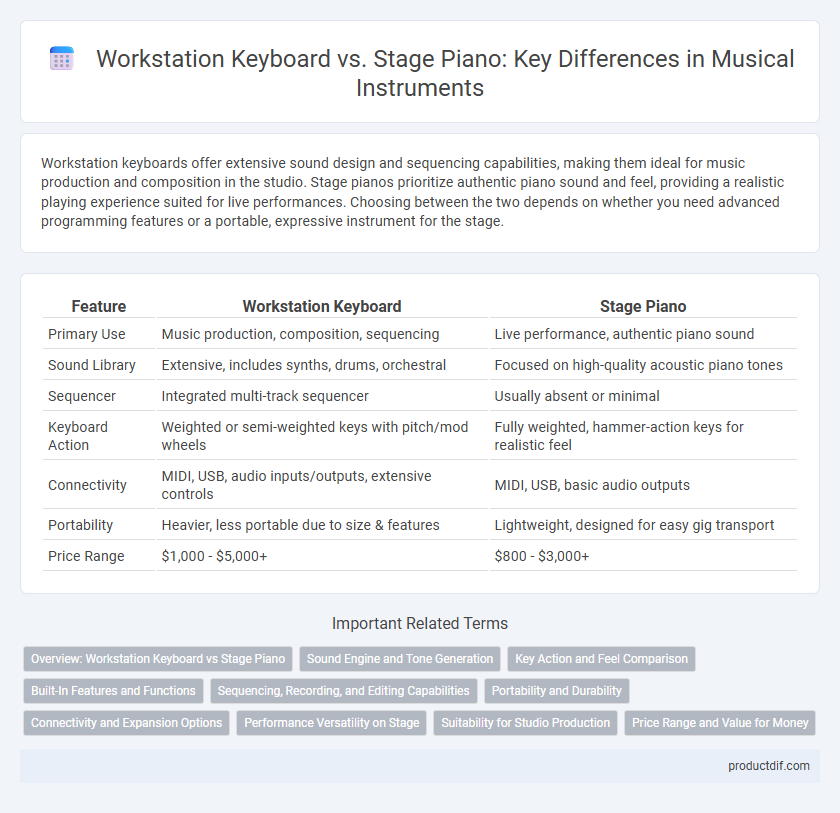Workstation keyboards offer extensive sound design and sequencing capabilities, making them ideal for music production and composition in the studio. Stage pianos prioritize authentic piano sound and feel, providing a realistic playing experience suited for live performances. Choosing between the two depends on whether you need advanced programming features or a portable, expressive instrument for the stage.
Table of Comparison
| Feature | Workstation Keyboard | Stage Piano |
|---|---|---|
| Primary Use | Music production, composition, sequencing | Live performance, authentic piano sound |
| Sound Library | Extensive, includes synths, drums, orchestral | Focused on high-quality acoustic piano tones |
| Sequencer | Integrated multi-track sequencer | Usually absent or minimal |
| Keyboard Action | Weighted or semi-weighted keys with pitch/mod wheels | Fully weighted, hammer-action keys for realistic feel |
| Connectivity | MIDI, USB, audio inputs/outputs, extensive controls | MIDI, USB, basic audio outputs |
| Portability | Heavier, less portable due to size & features | Lightweight, designed for easy gig transport |
| Price Range | $1,000 - $5,000+ | $800 - $3,000+ |
Overview: Workstation Keyboard vs Stage Piano
Workstation keyboards combine advanced sequencing, sound design, and sampling capabilities, making them ideal for music production and studio work. Stage pianos emphasize authentic piano sounds and robust key action, tailored for live performance and ease of transport. Both instruments serve distinct purposes, with workstation keyboards excelling in versatility and stage pianos prioritizing performance quality.
Sound Engine and Tone Generation
Workstation keyboards feature advanced sound engines with extensive tone generation capabilities, often including sampling, synthesis, and multilayered sounds for studio production. Stage pianos emphasize high-quality piano sound engines with detailed modeling of acoustic piano tones and key sensors tailored for live performance authenticity. The sound engine in workstation keyboards is optimized for versatility and sound design, while stage pianos focus on realistic touch response and pure piano timbres.
Key Action and Feel Comparison
Workstation keyboards typically feature semi-weighted keys that balance responsiveness and speed, ideal for complex sequencing and editing tasks. Stage pianos prioritize fully weighted, hammer-action keys to replicate the tactile feel of an acoustic piano, providing authentic expression and dynamic control. Musicians seeking versatility lean towards workstation key actions for diverse sound production, while pianists favor stage piano key feel for realistic touch sensitivity and performance nuance.
Built-In Features and Functions
Workstation keyboards offer extensive built-in features such as advanced sequencing, sound design tools, and a wide range of editable presets, making them ideal for music production and composition. Stage pianos prioritize high-quality piano sounds with weighted keys and essential performance controls, focusing on simplicity and reliability for live performances. The workstation's versatile functions contrast with the stage piano's streamlined design catering to expressive playing and ease of use on stage.
Sequencing, Recording, and Editing Capabilities
Workstation keyboards offer advanced sequencing, recording, and editing capabilities integrated within a single unit, allowing musicians to compose and arrange complete tracks directly on the instrument. Stage pianos primarily focus on high-quality piano sounds and performance features, with limited or no built-in sequencing and recording options, often requiring external gear or software for these functions. For producers and composers seeking all-in-one music production tools, workstation keyboards provide a comprehensive solution, whereas stage pianos appeal more to live performers prioritizing authentic piano feel and sound.
Portability and Durability
Workstation keyboards are designed with portability in mind, often featuring lightweight builds and compact designs that enhance mobility for gigging musicians. Stage pianos prioritize durability, incorporating robust construction and heavy-duty materials to withstand frequent transport and rigorous live performance conditions. Both instruments balance portability and durability differently, with workstation keyboards favoring ease of movement and stage pianos emphasizing resilience.
Connectivity and Expansion Options
Workstation keyboards offer extensive connectivity and expansion options, including multiple MIDI ports, USB interfaces, and audio inputs/outputs, allowing seamless integration with external devices and software. Stage pianos typically provide essential connectivity focused on durability and live performance, featuring balanced outputs, MIDI, and USB ports but often lack the advanced expansion capabilities found in workstations. Choosing between the two depends on whether the priority is studio versatility or streamlined live performance setup.
Performance Versatility on Stage
Workstation keyboards offer extensive sound design options, integrated sequencing, and customizable effects, making them ideal for musicians who require versatility during live performances. Stage pianos prioritize high-quality, authentic piano sounds and simple interfaces, ensuring reliable playability and straightforward control in dynamic stage environments. Performers seeking a balance between comprehensive production capabilities and expressive piano tones often choose based on their specific setlist requirements and performance style.
Suitability for Studio Production
Workstation keyboards are ideal for studio production due to their extensive sound libraries, built-in sequencing, and advanced editing capabilities, allowing musicians to compose, arrange, and record complex tracks within one device. Stage pianos prioritize authentic piano sound and feel but often lack integrated production features, making them less versatile for detailed studio work. Producers seeking a comprehensive all-in-one tool for music creation benefit more from workstation keyboards in a studio setting.
Price Range and Value for Money
Workstation keyboards typically range from $1,000 to $3,500, offering extensive sound design, sequencing, and recording capabilities that deliver excellent value for producers and composers. Stage pianos usually cost between $800 and $2,500, specializing in high-quality piano sounds and performance features, providing great value for live musicians seeking authentic keyboard tone and portability. Evaluating price versus features helps musicians select the best instrument for studio work or live performance needs.
Workstation Keyboard vs Stage Piano Infographic

 productdif.com
productdif.com